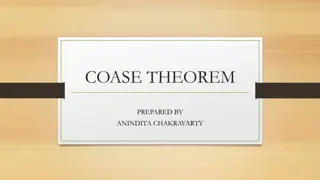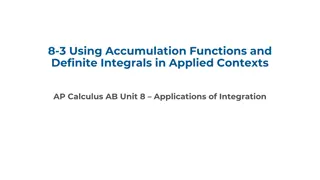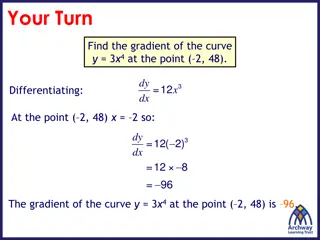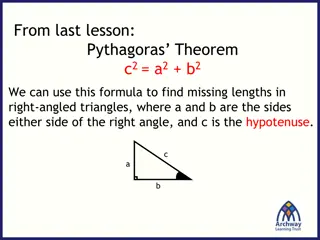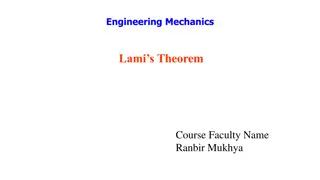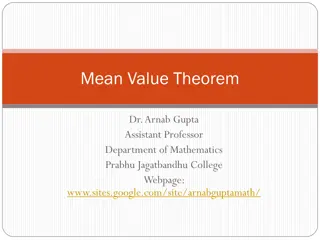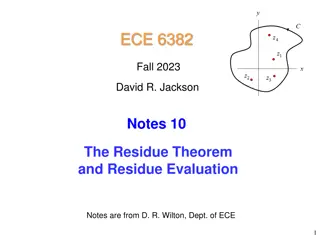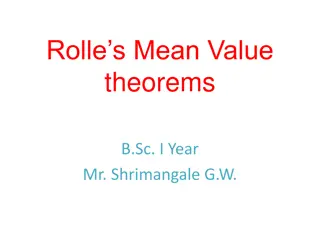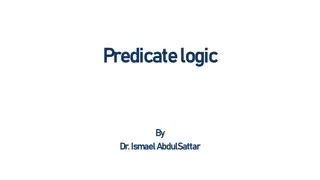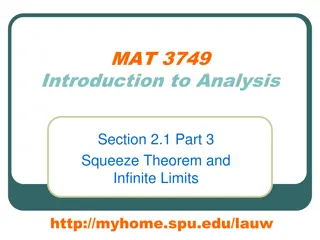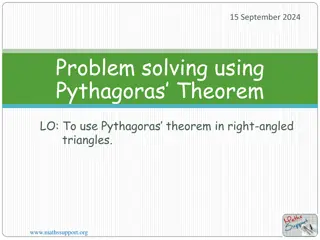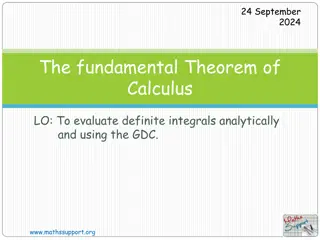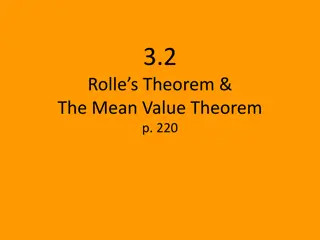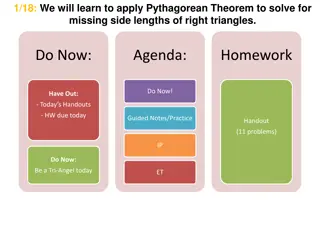Understanding the Fundamental Theorem of Calculus
The Fundamental Theorem of Calculus states that if a function is continuous on an interval and has an antiderivative on that interval, then the integral of the function over the interval is equal to the difference of the antiderivative evaluated at the endpoints. This concept is further explored through examples involving evaluation, differentiation, and integration processes. The theorem highlights how differentiation and integration are inverse processes that undo each other's operations.
Download Presentation

Please find below an Image/Link to download the presentation.
The content on the website is provided AS IS for your information and personal use only. It may not be sold, licensed, or shared on other websites without obtaining consent from the author. Download presentation by click this link. If you encounter any issues during the download, it is possible that the publisher has removed the file from their server.
E N D
Presentation Transcript
5.3 The Fundamental Theorem of Calculus NOTES: The Fundamental Theorem of Calculus: If f is continuous on [a, b] and F is an antiderivative of f on [a, b], then ? ? ? ?? = F(b) F(a) ? 1.) Act like the integral is an indefinite integral (antiderivative) and find the answer like you usually would, leave out the + C as it is no longer needed. 2.) (Evaluate at the top number) (Evaluate at the bottom number)
EX #1: Evaluate. = F 3 ( )- F 1 ( ) 3 ( ) 4 = F 2 ( )- F 1 ( ) 2 ( ) 3 3?3 ?? 2?2 3 ?? a.) 1 b.) 1 1 ( ) 1 ( ) 4 4 - F x ( )=x4 3 3 x3 3-3x F x ( )= -3 2 ( ) -3 1 ( ) = = - 4 3 4 =81-1 =80 - 8 3-6 1 3-3 = 20 = 4 2 =8-18-1+9 = -2 3 3
EX #1: Evaluate. = F 4 ( )- F 1 ( ) = 2 4 ( ) ( ) ( )-2 =16-2=14 ? 4???2? ?? - F 0 ( ) p 4 p 4 1 0 1 = 43 ? ?? c.) 1 d.) 0 F x ( )= tan x ( ) = F 3 2-2 1 ( ) 3 2-2 3 2 1 2 f x ( )= 3x - tan 0 ( ) = tan = 2x 3 2 3 2 x 32 F x ( )= 3 = 2 22 = 2 23
3 6 3 v v v v 1 v ( ) f v = + 3 ln F v v = + = + 2 EX #1: Evaluate. 3v 4 4 = F 2 ( )- F 1 ( ) = F 6 ( )- F 3 ( ) = ln 6 ( )-ln 3 ( ) 6 3 2 ?3+3?6 6 ?? f.) 1 ?? e.) 3 f x ( )=1 ? ?4 No need for absolute value bars. 0 ( ) ( ) ( ) ( ) ln 2 ( ) ( ) ln 1 3 3 x = + + 2 1 = ln 2 ( ) F x ( )= ln x = ln ( ) = + ln 2 7
EX #2: Find the area of the region bounded by the graph of ? = 2?2 3? + 2, the x - axis, and the vertical lines x = 0 and x = 2. ( 0 0 2 2x2+2x ) dx =2 3x3-3 2 2x2-3x+2 - 2 32 ( ) 3-3 2 ( ) 2+2 2 ( ) 2 30 ( ) 3-3 0 ( ) 2+2 0 ( ) = 2 2 =16 3-12 2+4 =16 3-2=10 3 2
Differentiation and Integration as Inverse Processes: We end this section by bringing together the two parts of the Fundamental Theorem. We noted that Part 1 can be rewritten as which says that if f is integrated and then the result is differentiated, we arrive back at the original function f. Since F (x) = f (x), Part 2 can be rewritten as This version says that if we take a function F, first differentiate it, and then integrate the result, we arrive back at the original function F, but in the form F(b) F(a). Taken together, the two parts of the Fundamental Theorem of Calculus say that differentiation and integration are inverse processes. Each undoes what the other does.
EX #3: Evaluate. a.) ? ?? 0 x 2 3 ?3? ?? d dx t ?? ?2+ 1 ?? ( 0 b.) Find F (x). ? ? = 0 = 2 0 ) x = + 3 t t dt 2 3 d dx x = 3x = 0 2 x = 4 2 4 2 d dx t t d dx x x ( ) = + = + = + + 3 2 1 0 x x x x 4 2 4 2 0 ????2? ?? c.) ? ? d.) ? ?? ? If g x ( )= by FTC1, g' x ( )= f x ( )= sec2x ( ) ?2+ 1?? ?? 0 4 If g x ( )= by FTC1, g' x ( )= f x ( )= sec2t ( ) x x t2+1 dt, then dt, then p 4 0 x2+1
EX #4: Find the derivative of ? ? = ? Let u = x3anddu =d dx 2 Other than x . dx= 3x2. ?3cos? ?? F' x ( ) cos t ( ) u dt 2 p F' x ( ) d dx 3 ( ) t x = sin =d du dx cos t ( ) 2 u Chain Rule. dt p 2 dx d dx ( ) x = 3 sin sin 2 = cos u ( ) du By FTC1. ( ) 3x2 ( )-1 =d dx = cos x3 sin x3 ( ) 3x2 dx = cos x3
EX #5: Find F (x). ? ? = ? -x 0 x x ??3 ?? = + = - + t3dt t3dt t3dt t3dt -x 0 0 0 F' x ( )= - -x ( ) 3-1 ( )+ x ( ) 31 ( ) = -x3+ x3=0 Chain Rule and FTC1. cos t ( ) 1-t2dt cos t ( ) 1-t2dt ( ) 1- x2 ( ) cos t ( ) 1-t2dt cos t ( ) 1-t2dt ( ) 1- x4 ?2??? ? 1 ?2?? = x2 x2 -x 0 Find F (x). ? ? = ? + = - + -x 0 0 0 ( ) =cos x ( ) cos -x ( 1- -x ( ) 2 2x cos x2 cos x2 F' x ( )= - -1 ( ) + 1- x2+ 2x ) 2
EX #6: Find F (x). ? ? = 0 ?2sin?2?? ( ) ( ) F' x ( )= sin x2 2 2x = 2x sin x4
EX #7: f t ( ) f t ( ) f t ( ) 0 (b) g (x) = f(t) g (x) > 0, increase (0, 4) g (x) < 0, decrease (4, 8) (a) g(0) = = 0 0 2 g(2) = 7 0 (c) Relative max at x = 4, (4, 9) 4 g(4) = 9 0 f t ( ) f t ( ) 6 g(6) = 9-1=8 0 8 g(8) = 8-3=5 0




